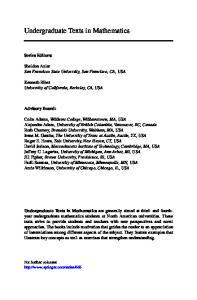Recent progress about 2D metal dichalcogenides: Synthesis and application in photodetectors
- PDF / 4,971,814 Bytes
- 21 Pages / 612 x 808 pts Page_size
- 80 Downloads / 279 Views
Recent progress about 2D metal dichalcogenides: Synthesis and application in photodetectors Yongfeng Pei, Rui Chen, Hang Xu, Dong He, Changzhong Jiang, Wenqing Li (), and Xiangheng Xiao () Department of Physics and Key Laboratory of Artificial Micro- and Nano-structures of Ministry of Education, Hubei Nuclear Solid Physics Key Laboratory, Wuhan University, Wuhan 430072, China © Tsinghua University Press and Springer-Verlag GmbH Germany, part of Springer Nature 2020 Received: 25 August 2020 / Revised: 23 September 2020 / Accepted: 7 October 2020
ABSTRACT In recent years, two-dimensional (2D) layered metal dichalcogenides (MDCs) have received enormous attention on account of their excellent optoelectronic properties. Especially, various MDCs can be constructed into vertical/lateral heterostructures with many novel optical and electrical properties, exhibiting great potential for the application in photodetectors. Therefore, the batch production of 2D MDCs and their heterostructures is crucial for the practical application. Recently, the vapour phase methods have been proved to be dependable for growing large-scale MDCs and related heterostructures with high quality. In this paper, we summarize the latest progress about the synthesis of 2D MDCs and their heterostructures by vapour phase methods. Particular focus is paid to the control of influence factors during the vapour phase growth process. Furthermore, the application of MDCs and their heterostructures in photodetectors with outstanding performance is also outlined. Finally, the challenges and prospects for the future application are presented.
KEYWORDS metal dichalcogenides, vertical/lateral heterostructures, vapour phase methods, photodetectors
1
Introduction
In past decade, two-dimensional (2D) metal dichalcogenides (MDCs) have drew great attention on account of their unique physical and chemical properties. For example, they can interact strongly with light, thus having high light absorption efficiency. The chemically inert surfaces protect them from degradation. Most importantly, their tunable band gaps ranging from 1 to 2.5 eV grant them broad band response. Compared with their bulk counterparts, 2D MDCs have layer dependent band gap, and indirect-to-direct band gap transition will occur when the thickness decreases down to single layer. In particular, diverse 2D MDCs materials can be integrated into van der Waals (vdWs) heterostructures beyond the limitation of lattice mismatch [1–7]. Moreover, two materials with similar lattice constant could stitch seamlessly to form in-plane lateral heterostructures [8–13]. Because of their tunable band gap and atomically sharp interfaces, 2D MDCs materials and their heterostructures show enormous potential for optoelectronic device applications [14–20]. Therefore, the reliable methods to obtain large-area, high-quality 2D MDCs and their heterostructures are undoubted the building blocks for their wide application. Mechanical exfoliation method is the first proposed method to prepare 2D materials. Since the succe
Data Loading...










